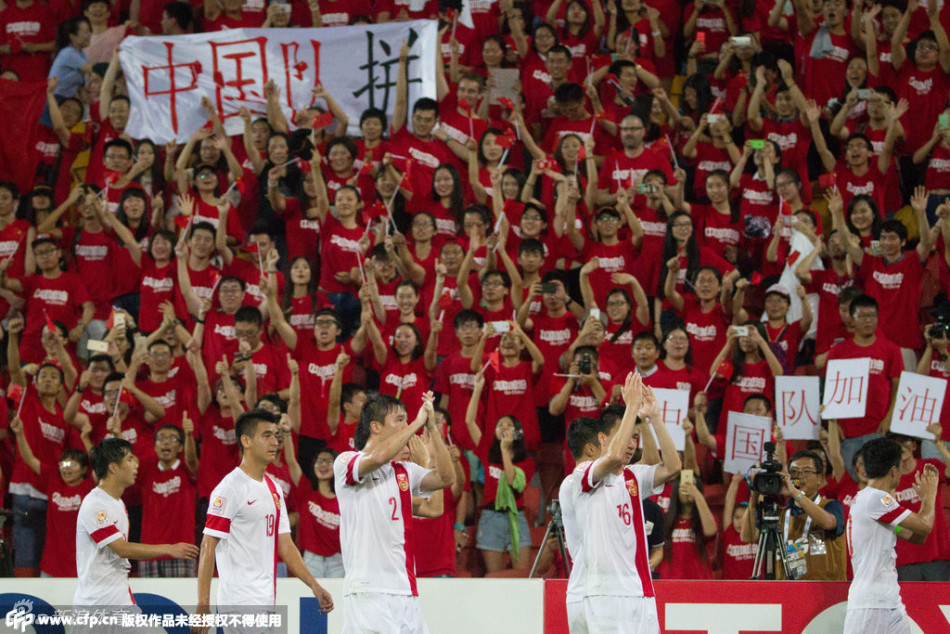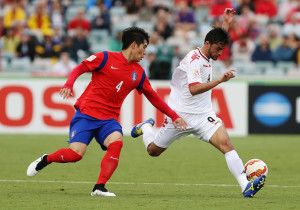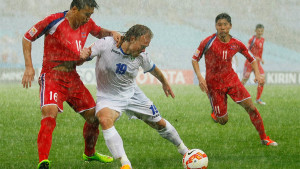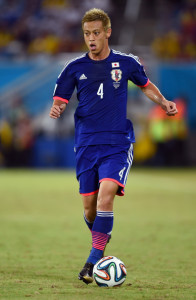The Chinese national team returns to action this weekend when the EAFF East Asian Cup kicks off in Wuhan and WEF tells you everything you need to know about the tournament. Among other things, we let the uninitiated know what the competition actually is, outline a brief history of the tournament and take a look at what to expect from China’s opponents – South Korea, North Korea and Japan.
What is the EAFF East Asian Cup?
This year’s East Asian Cup will be the sixth edition of the competition organised by the East Asian Football Federation (EAFF) every two or three years since 2003. A successor to the very similarly structured Dynasty Cup, which ran four times between 1990 and 1998, it is a four team round-robin competition to be held in Wuhan between the 2nd and 9th of August.
As always, East Asian football’s traditional big three of China, South Korea and Japan qualify automatically and they will be joined in this year’s competition by North Korea who came through a preliminary competition held in Taiwan in November.
Significantly, the tournament isn’t played on official FIFA dates, meaning that only players who represent East Asian clubs are eligible. This gives a distinct advantage to China who, with the exception of recent Rayo Vallecano acquisition Zhang Chengdong, have an entirely domestic based talent pool. Conversely, many of Japan and South Korea’s top stars play their football in the leagues of Europe and, in the case of the latter, West Asia.
The East Asian Cup is not a FIFA recognised tournament and so, for rankings purposes, the games only count as friendlies, but there is plenty of pride on the line as China take on historical friends and enemies for regional bragging rights.
Brief History
The first tournament was held in three different venues across Japan in 2003 and was won by South Korea when they held the hosts to a 0-0 draw in the final game to take the trophy on goal difference. Third placed China’s only win that year came over hopeless qualifiers Hong Kong, but they rectified things two years later by lifting the trophy in South Korea.
After score draws with both South Korea and Japan, goals from Li Yan and Xie Hui gave China a 2-0 victory over North Korea who had earned a surprising 1-0 win over Japan in the opening game. In the final match, the hosts needed a high scoring two goal victory to usurp China’s position at the top of the table, but ended up losing 1-0 and finishing in last place.
In 2008, the tournament came to China for the first time where it was held in Chongqing. Unfortunately for the home support, things did not go well as the hosts fell 3-2 to South Korea and 1-0 to Japan in their first two games. A 3-1 victory over North Korea in the final game was enough to prevent China finishing bottom as South Korea once again tied Japan in their last game to take the trophy on goal difference.
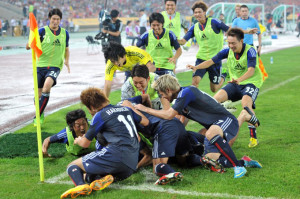
Japan celebrate the last minute goal from Yoichiro Kakitani which made them 2013 East Asian champions
Two years later, the competition was held in Tokyo where China took their second title and did it without conceding a goal. A 0-0 draw with Japan in the opener was followed by an historic 3-1 win over South Korea and a 2-0 victory over qualifiers Hong Kong, who conceded a total of ten without reply. Japan needed at least a two goal victory over South Korea in the final game to overtake China, but they fell 3-1 to once again miss out.
In the most recent edition, held in South Korea in 2013, Australia took part for the first (and only) time and duly qualified to greatly strengthen the final round. Late goals from Wang Yongpo and Sun Ke gave China a 3-3 draw with Japan in the first game before playing out a stalemate with South Korea in the second. A wild 4-3 victory over Australia, featuring four goals in the last four minutes, meant that China could win their third title if Japan lost to or had a scoreless draw with South Korea. For the first time, though, the Japanese came through in the deciding game as a stoppage time goal from Yoichiro Kakitani secured a 2-1 win and a maiden title for the Samurai Blue.
Location
With the last two tournaments being held in Japan and South Korea, it’s China’s turn to play host and, as part of the CFA’s drive to take international games to cities without Super League teams, Wuhan has been selected to hold the tournament. The capital of Hubei province has a strong footballing heritage, with many current and recent international players such as Zeng Cheng, Mei Fang, Hao Junmin and Zhang Xizhe hailing from the city.
The two major issues with hosting the tournament in China’s ninth biggest city are climate and stadium location. Wuhan is considered one of China’s four ovens and with temperatures often getting close to 40 degrees celsius in the summer months it’s easy to why. All games will be held at night or the early evening when the temperature will be lower, but the humidity remains oppressive and will likely slow down the speed of games. As was shown just last Thursday, the Wuhan summer also has the potential for the occasional crazy rain storm which can bring the city temporarily to its knees.
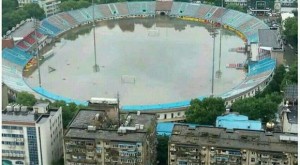
Wuhan’s Xinhua Road Stadium (pictured last Thursday) shows the potential damage heavy summer rains can do in the city
League One team Wuhan Zall’s Xinhua Road Stadium ended up under a metre of water as a result of last week’s deluge but, as that ground is not up to international standards, East Asian Cup matches will be held in the 50,000+ capacity Wuhan Sports Centre Stadium. Like most stadiums in China, it’s a modern facility with a running track that makes it less than ideal for watching football.
The major disadvantage of the ground, though, is its location. Buried out in an industrial zone, and without a subway station until at least 2016, it usually takes a minimum of an hour to travel there from Wuhan’s most densely populated areas of Wuchang and Hankou. With post-match transport back to the city unreliable at best, many potential spectator’s can be put attending matches.
However, a friendly with Thailand, held at the ground last October, managed to attract 21,000 fans on a Friday night and there is an increasing buzz in the city surrounding the tournament. China’s weekend matches against South Korea and Japan should be well attended but, with work commitments making midweek attendance more difficult, there is a danger of a relatively sparse turnout for Wednesday’s match against North Korea. Crowds for the women’s competition, with games being held the day before the men’s matches, are also likely to be adversely effected by the stadium’s inaccessibility.
China’s Opponents
South Korea
Remarkably, China’s triumph over South Korea in the 2010 edition of the East Asian Cup was the first time they had ever beaten them. In 27 matches between the teams, that remains China’s solitary victory with ten others ending in draws and sixteen in defeats.
With twelve of the 23-man squad which got South Korea to the final of this year’s Asian Cup based in Europe or West Asia, China certainly have a good opportunity to pick up a second ever win over their weakened opponents.
It won’t be easy though. Star players such as Swansea City’s Ki Seung-yueng and Bayer Leverkusen’s Son Heung-min may be missing, but the Koreans still have plenty of quality players plying their trade in East Asia. The foundations of the compact defensive unit which saw them keep five clean sheets in the Asian Cup will be tough to break down and the Chinese players will see some familiar faces among them.
Centre backs Kim Young-gwon and Kim Ju-young, of Guangzhou Evergrande and Shanghai SIPG, both in the squad, as is Guangzhou R&F’s Jang Hyun-soo. The 23-year-old started his career at centre back but has been increasingly deployed as a holding midfielder for both club and country.
The South Koreans are currently ranked 52nd in the world and 3rd in Asia behind Japan and Iran.
North Korea
The North Koreans will be participating in their third East Asian Cup finals after breezing through the preliminary round held in Taipei last November. A FIFA world ranking of 129 – eighteenth in Asia – suggests a side which should be push overs, but their position in those standings is always artificially deflated by the diplomatic difficulties they have arranging friendlies with high ranking nations.
Indeed, they made somewhat of a mockery of their placing in pot 4 of April’s World Cup qualification draw when they dispatched top seeds Uzbekistan 4-2 in Pyongyang in June. That victory also gave the North Koreans some measure of revenge for a narrow 1-0 defeat the Uzbeks handed them in the first match of January’s Asian Cup.
They went on to suffer a comprehensive 4-1 loss to Saudi Arabia in their next match, before falling 2-1 to China in their final outing. Admittedly, that game was a dead rubber, but the North Koreans fought back from being 2-0 down at the interval to have much the better of the second half. That was China’s tenth win in nineteen meetings with their historical ally, but the ferocious way in which the North Koreans contested their last 45 minutes in Australia tells us a win can’t be taken for granted.
With few individual stars, the North Koreans rely on hard work, dedication and playing as a collective. They also have a tendency to get overly physical when things aren’t going their way, meaning the potential to pick up injuries is a worry.
Japan
Like South Korea, Japan arrive in Wuhan shorn of many of their best players. Captain Makoto Hasebe, Inter Milan full back Yuto Nagatomo, Southampton centre back Maya Yoshida, recent Leicester City acquisition Shinji Okazaki, Borussia Dortmund playmaker Shinji Kagawa and talismanic AC Milan forward Keisuke Honda are all absent, and Bosnian manager Vahid Halilhodzic has opted to bring a very inexperienced side with him to China. Nobody in his 23-man squad is over the age of 29 and centre back Masato Morishige’s 23 caps makes him the team’s most experienced player.
This year has been a mixed one for Japan with a flawless Asian Cup first round, in which they claimed three wins without conceding a goal, followed by a disappointing quarter-finals exit courtesy of a penalty shoot-out with the United Arab Emirates. After the tournament, Mexican manager Javier Aguirre was let go due to his alleged involvement in match-fixing in La Liga and was replaced Halilhodzic.
The Bosnian, who won many admirers while overseeing Algeria’s run to the 2014 World Cup second round, began life in Japan with friendly wins over Tunisia, Uzbekistan and Iraq, but things took a turn for the worse when the Blue Samurai were held to a 0-0 draw in Singapore in their first World Cup qualifier. The Japanese, who are the current holders of the East Asian Cup, come into the tournament ranked 50th in the world and 2nd in Asia.
Considering their woeful record against South Korea, China have a surprisingly good set of results against Japan – their 25 meetings ending in nine wins a piece and seven draws. However, that perhaps owes more to Japan’s late development as a regional footballing power than anything else as recent meetings between the two have not gone well for the Chinese. Guozu have never won an Asian or East Asian Cup match between the sides and their most recent victory over Japan came all the way back at the 1998 Dynasty Cup.
Of course, with Japan playing in China, the potential for an electric and raucous atmosphere needs to be taken into consideration. There is without doubt strong anti-Japanese feeling in China. This is not the right platform to delve into the reasoning behind that, but the riots which followed China’s defeat to Japan in the 2004 Asian Cup final held in Beijing show that this can sometimes cross over into football.
Interestingly, of all the protests which took place across China in 2012 due to increased rhetoric surrounding the Diaoyu Islands, the ones in Wuhan were most virulent, with the destruction of Japanese cars and businesses attracting international attention. Hopefully, everything will pass off peacefully pre and and post-game, but the Japanese will likely have to contend with a very hostile atmosphere as well as an improving Chinese team.
Expectations
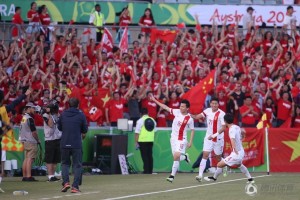
China will hope to have more to celebrate this summer after making January’s Asian Cup quarter-finals
Despite renewed faith in the national team after they made the Asian Cup quarter-finals for the first time in eleven year, there are few who would dispute that China remain a second tier Asian footballing power behind the likes of Japan, South Korea, Australia and Iran. However, things seem to be going in the right direction and lifting a trophy on home soil can help the Chinese build momentum for when their World Cup qualifying campaign continues in September.
With Japan and South Korea’s under-strength squads giving them ready made excuses for failure and North Korea generally expected to make up the numbers, China have the most to lose with a poor performance in Wuhan. This competition gives China the opportunity to prove they are closing the gap on their more successful neighbours and they shouldn’t go into the tournament aiming for anything other than top spot.
Overcoming the lite versions of Japan and South Korea could be considered a hollow victory, but it’s a necessary one if China are to continue moving forward. Should China make it that far, the Japanese and South Koreans are potential opponents in the final round of World Cup qualifying and it will be psychologically difficult to beat teams featuring the Ki Seung-yuengs and Shinji Kagawas if you can’t beat teams without them.
This tournament may not mean much in the grand scheme of things, but it’s one China should go all out to win. If they are able to avoid crumbling under the weight of expectation, they just might be able to claim their third East Asian title.
Fixtures
Sunday August 2nd
Japan vs North Korea (18:20), China vs South Korea (21:00)
Wednesday August 5th
Japan vs South Korea (18:20), China vs North Korea (21:00)
Sunday August 9th
South Korea vs North Korea (17:10), China vs Japan (20:10)
Check back tomorrow for a closer look at China’s squad for the tournament.
